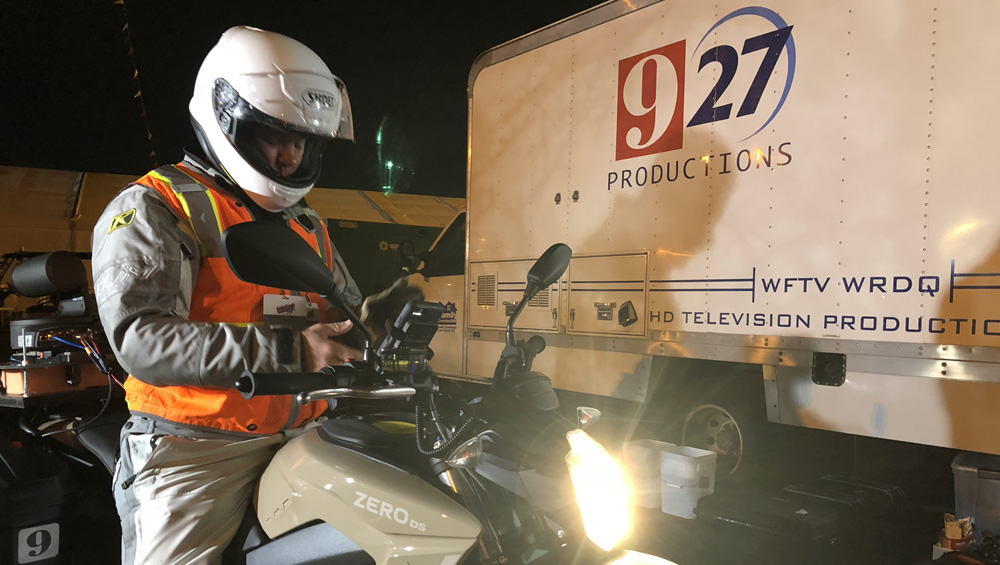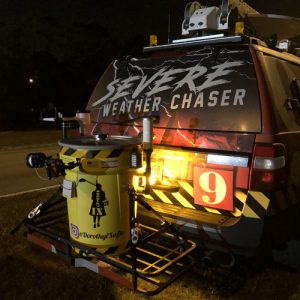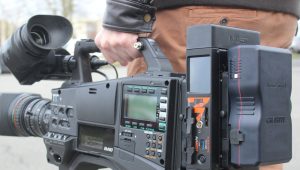
Stations Look To Stream From Any Device


WFTV installed a Panasonic PTZ camera on the back of an electric scooter to cover a marathon. To ensure the scooter driver’s safety, a person at the station remotely controlled the camera and communicated with the driver over the 4G network. Source: WFTV
To cover live a local marathon last January, WFTV Orlando, Fla., used a dozen streaming cameras, including a Panasonic PTZ mounted on the back of an electric scooter.
“We used every device we had that streamed,” says Dave Sirak, director of news technology at the Cox ABC affiliate.
To ensure the scooter driver’s safety, a tech at the station remotely controlled the camera with a device the size of a “hockey puck” and communicated with the driver, all over a 4G link, Sirak says.
Until the broadcast, Sirak says, such uses might have been considered experimental or for emergencies only. “Now we want more streaming cameras, more motorcycles, more pictures,” he says. “Streaming capability is a necessity, not an add-on. There is now a requirement or expectation to stream from any device.”
Many stations share WFTV’s expectation and the vendors are responding with bonded cellular and other wireless gear to improve efficiencies and connectivity and add new capabilities like remote control.
At the same time, they are working to incorporate the coming high-speed 5G wireless technology.
TVU Networks CEO Paul Shen says broadcasters will continue to see improvements in efficiency, portability and ease of use for field transmission devices. “More importantly, we will see the integration of transmission devices into the supply chain process.”
TVU’s field transmitters simultaneously use six SIM cards, and the company plans to show its TVU One cellular mobile transmitter with support for 4Kp60 at the NAB Show this year.
Such advancements are significant, but merely part of the bigger workflow picture, Shen says. “Companies should really be thinking beyond just transmission and asking themselves how acquisition fits into their overall workflow.”
Some of the new tools let journalists send their contributions to the station with the click of a button, and for the station to remotely operate the equipment, all while significantly speeding up workflows.
“Customers expect more and more connectivity with third-party products,” says Steven Cooperman, senior product manager, Panasonic System Solutions.
While the streaming-capable camcorders themselves record 4K video, they can send a lower res — and therefore smaller — version of the video to the cloud using a wifi hotspot, says James Long, another Panasonic exec.
Within minutes, anyone with access to the cloud can view the video and promo it. “They don’t have to wait around for a live shot to happen at a certain time of the day.”
It’s “one of the bigger changes to happen to the news guys,” Long says.

The marathon was the first time WFTV used Dorothy IX, its remote camera setup intended to operate unmanned to provide storm coverage when it’s dangerous for journalists to remain on location. Source: WFTV
And that connectivity works two ways. “The station itself can reach out to the camera,” Long says. “If the photographer didn’t white-balance the camera, they can remotely correct it.”
For the marathon that WFTV covered, the station could “control, receive, pan, tilt, white balance remotely, on the fly.”
The AG-CX350, the first in Panasonic’s new series of handheld camcorders, is also the company’s first connectivity camera under $4,000, Cooperman says.
Commercialized at the end of February, it is targeted for use in live broadcasting with features like 4K 10-bit 60p capture, HDR recording, and an RTMP/RTSP function for live streaming and NDI | HX-ready IP connection.
Some years back Sony introduced camcorders capable of encoding and transmitting from the camcorder to the receiver at the station. Now Sony offers 10 camcorders with streaming and file transfer functionality. Its newest camcorder offering is the XDCAM air, which can be used as a standalone system or integrated into studio workflows.
The camcorders provide geolocation data, which makes it possible to locate the units on a GPS map and identify and deploy whichever is closest to a breaking news event, he adds. The units can handle FTP transfer from the camera to the station.
The camcorders feature two USB slots, permitting the use of two LTE modems to ensure strong signal quality. The duo-linked units can constantly adjust the bandwidth over the two carriers based on signal strength, says Martin Lindsay, a product manager at Sony.
It’s a “massive opportunity” for customers who don’t want to rely on a single network connection, he says. “It allows management of the camera from the cloud.”
Live events with multiple cameras require all the units to be in “perfect sync,” says Jim Jachetta, EVP of engineering and CTO at VidOvation.
For the Ryder Cup, Turner Sports needed to handle 16 contribution feeds from Paris to Atlanta and four return program feeds from Atlanta to Paris, all via a one gb/second unmanaged public internet connection.
Jachetta says VidOvation provided technology that delivered “perfect video gunlock and lip sync across multiple cameras” using AVIWEST’s HE4000 4K UHD and HD HEVC live encoder and PRO Series bonded cellular transmitter.
AVIWEST also converted the standard European framerate of 50 Hz to the American framerate standard of 59.94 Hz.
Over the four-day event, “barely a packet was dropped. It worked flawlessly, all synchronized from 16 cameras,” Jachetta says.

The AVIWEST PRO380 camera mount HEVC encoder with bonded cellular and public internet transmission. Source: Vidovation
VidOvation’s AVIWEST solution is also in use on Live PD, a Big Fish Entertainment program that follows officers on patrol in six cities streaming up to 40 live HD video feeds to a control room in the A&E headquarters in New York to air the program in real time. Each patrol car is covered with multiple cameras inside and out, and footage must sync properly, Jachetta says.
The advent of 5G cellular networks is the next Big Thing.
“What’s the impact of 5G, and what’s the impact of cameras starting to deploy cellular,” asks Jim Casabella, a media technology consultant and former director of advanced technology for ABC Television. “Is that going to eliminate or reduce the use of bonded cellular? That’s the dynamic that’s happening now.”
The technology is said to be capable of handling data speeds potentially exceeding 1 gbps, and bonded cellular companies are designing for such a future.
“Some are like, ‘5G is going to solve everything,’ ” says Todd Schneider, Dejero CTO. But it’s going to be years before it is everywhere, he adds. In the meantime, LTE service will remain vital for the broadcast industry.
“That’s where we see our blending technologies going, blending 5G and LTE,” Schneider says.
Like Dejero, LiveU is preparing to roll out services to meet the 5G world. “We’re working with all the carriers now,” says Mike Savello, VP of sales at LiveU. “We have prototypes in the labs.”
He says the move to 5G could “become even more of a replacement for satellite and microwave trucks over time.”
One of the recent game-changers, he says, is H.265, the next generation in video compression.

LiveU’s LU300 HEVC field unit helps G1 Motorseries Griiip Racing. The system is essentially set up as a remote production allowing Griiip or other production teams to switch feeds and produce the live event from anywhere. Source: LiveU
“It doubles the reliability of our solutions overnight,” Savello says. “It can transmit the same quality of video as before in half the bandwidth.”
The company’s LU600 portable transmission unit combines with a 4K high efficiency video coding (HEVC) ProCard. LiveU chose to use hardware rather than software on Intel processing because of the huge amount of compute cycles that would be needed, Savellow says.
Even with a powerful CPU, he adds, it could still sacrifice on quality while burning through the battery. A dedicated chip, on the other hand, uses little power but meets the demanding processing requirements imposed by HEVC, he says.
In January, Sinclair Broadcast Group signed a $20 million multi-year lease agreement to upgrade its fleet of portable transmission units to LU600 HEVC at 80 locations in the U.S.
































Comments (0)